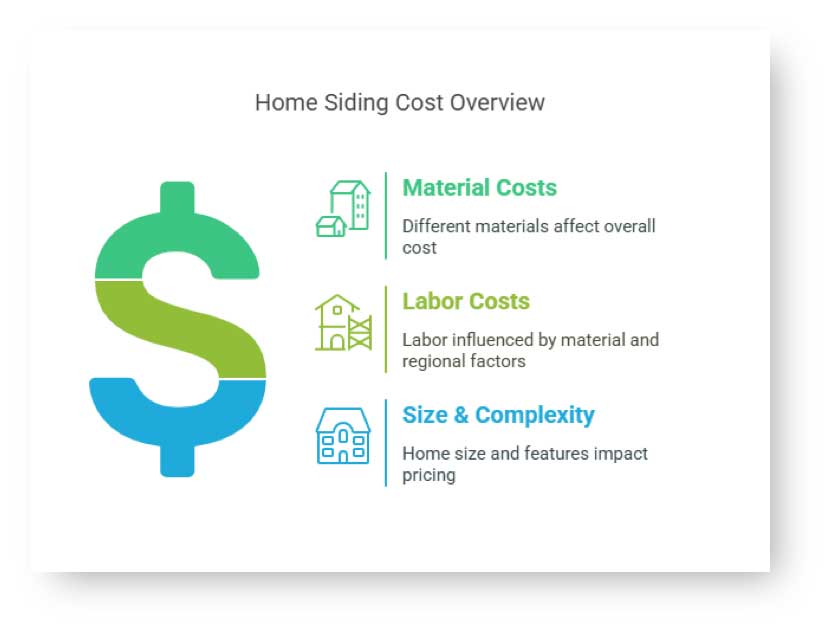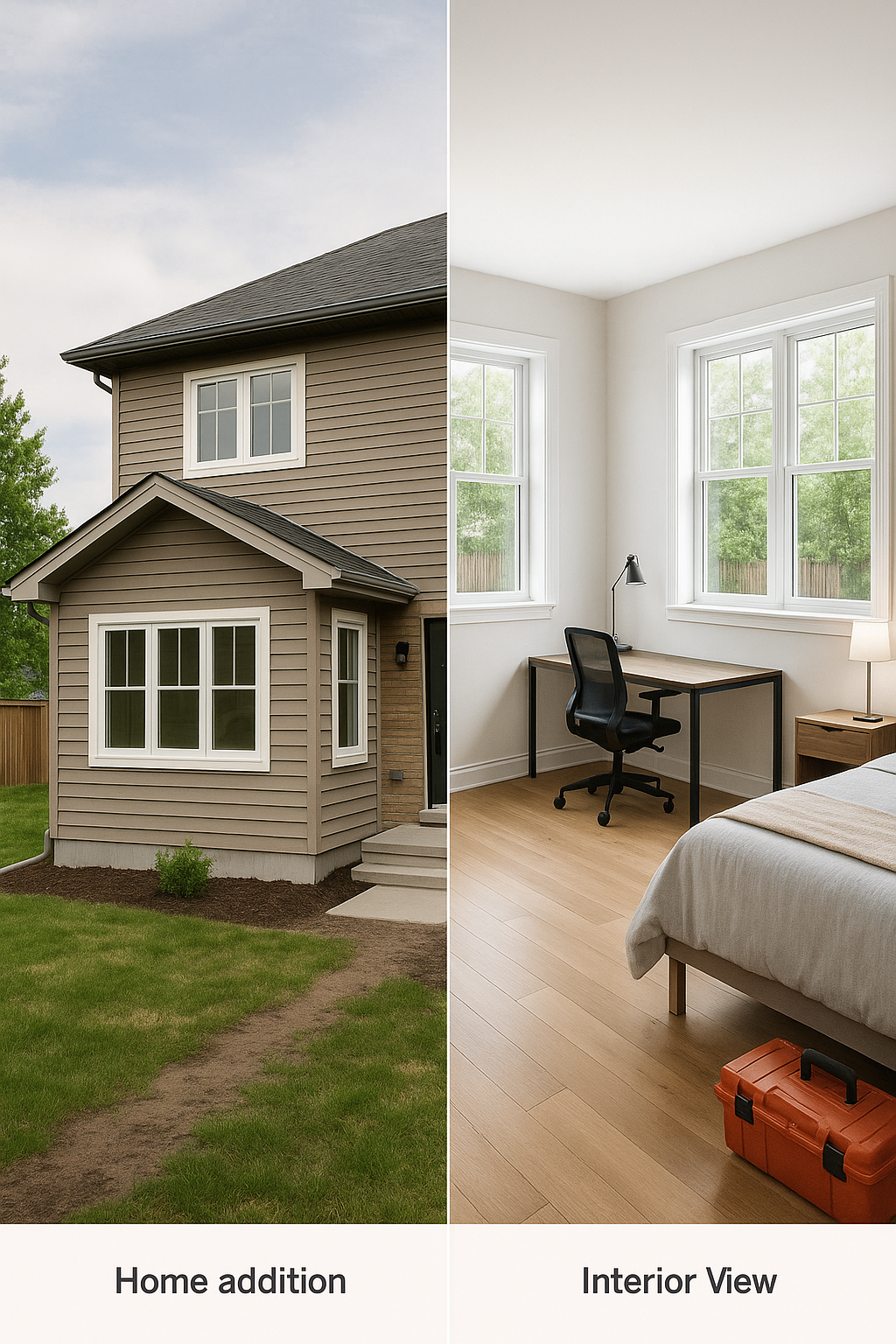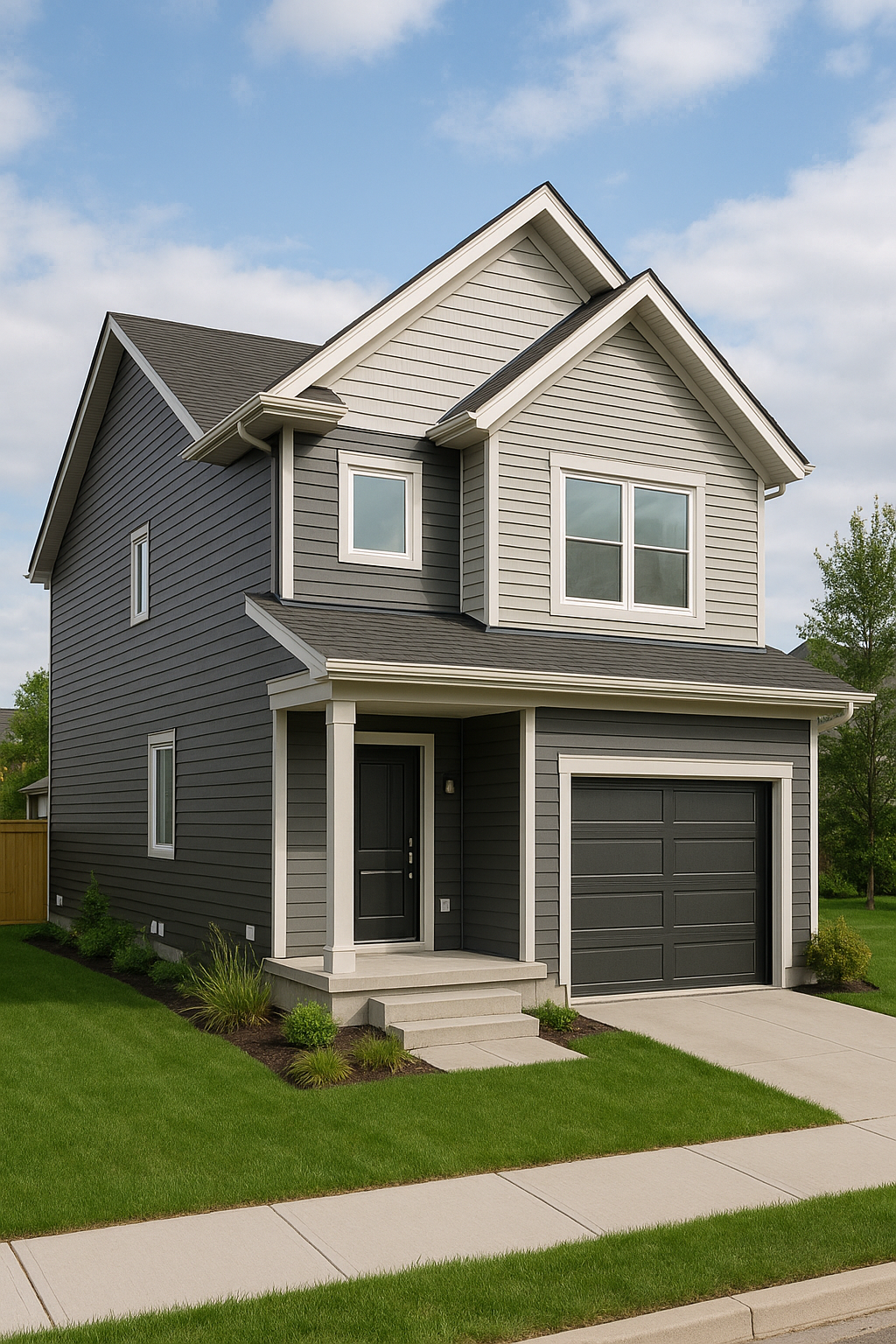When it comes to home renovations, few projects offer as significant a return on investment (ROI) as a siding upgrade. Not only does new siding enhance the aesthetic appeal of a home, but it also plays a crucial role in protecting the property and increasing energy efficiency.
Vinyl siding replacement stands out as the 5th most valuable home renovation project in 2023. This upgrade brings back an impressive 94.7% of the investment. Recent market trends also show fiber cement siding delivers strong returns at 88.5%.
.
Contents
- The ROI of a Siding Upgrade: Boosting Home Value
- Understanding Siding ROI in Today’s Market
- Current ROI statistics for different siding materials
- How siding ROI has changed since 2019
- Regional variations in siding replacement ROI
- Cost Breakdown: What Impacts Your Siding Replacement Cost
- Material costs comparison (vinyl, fiber cement, wood, etc.)
- Labor and installation expenses
- Size and complexity factors
- ROI Comparison: How Siding Stacks Up Against Other Home Upgrades
- Siding vs. window replacement ROI
- Siding vs. kitchen/bathroom remodels
- Why exterior projects often yield better returns
- Why Buyers Notice Exterior Aesthetics First
- Case Studies: Homes That Saw a Market Boost After a Siding Upgrade
- Maximizing Your Siding Investment
- Selecting materials to get optimal ROI on siding
- Strategic timing for your upgrade
- Working with the right contractor
- How Siding Protects Your Home and Increases Energy Efficiency
- Conclusion
- Understanding Siding ROI in Today’s Market
- Frequently Asked Questions
Understanding Siding ROI in Today’s Market
Home siding investments have changed a lot, and exterior projects now top the list for best returns. All but one of these top ten home improvement projects that give the best returns are exterior upgrades.
Current ROI statistics for different siding materials
Fiber cement siding stands at the top with an 88.4% return on investment. Vinyl siding comes in next with an 80.2% ROI. These high returns come from better durability, improved energy efficiency, and a boost in curb appeal.
How siding ROI has changed since 2019
Siding ROI numbers tell an interesting story. These projects have always ranked high for investment returns, but their performance has jumped up since 2019. Here’s why:
Many homes built in the 1960s-1980s now need their original siding replaced
- Homeowners can choose from more products and better designs
- People focused on fixing up their home’s exterior during the pandemic
- Regional variations in siding replacement ROI
Location plays a big role in what you’ll get back from siding replacement. These differences often come down to local market conditions, climate, and what buyers want in each area. To name just one example, Midwestern markets value energy-efficient options like fiber cement more than less efficient choices. Weather patterns and popular building styles in each region also affect which materials work best, and this shapes what buyers want and what they’ll pay.
Cost Breakdown: What Impacts Your Siding Replacement Cost
The cost to replace your home’s siding depends on your choice of materials, how much work needs to be done, and the project’s complexity. Most homeowners spend between CAD 10,000 and CAD 40,000.
Material costs comparison (vinyl, fiber cement, wood, etc.)
Your choice of materials plays a huge role in the final cost. Vinyl siding is the most affordable option while fiber cement costs more and gives you better durability and protection against weather.
Looking at high-end options, brick siding sometimes cost more than stone sidings while Wood sidings sits in the middle.
Labor and installation expenses
The labour charge for Siding Installation is based on:
- How complex the material is to install
- What workers charge in your area
- When you schedule the project and seasonal timing
- What equipment the job needs
Taking off old siding adds up to $3000 to your total cost. Some materials like fiber cement need special installation techniques, which makes labor costs go up.
Size and complexity factors
Your home’s design features make a big difference in the final cost. Two-story homes usually cost 15% to 30% more than single-story homes. Other things that affect the price include:
- Special features like dormers, gables, or turrets
- The condition of your walls and repairs needed before installation
- How easy it is to access your home
- The time of year you plan the project
A 2,000-square-foot home typically costs around CAD 25,000 with standard siding materials. But if you go with premium options like stone or brick, your cost could go way up.
ROI Comparison: How Siding Stacks Up Against Other Home Upgrades
Siding replacement delivers exceptional returns among home improvement projects. Recent data shows fiber cement siding provides an 88.4% ROI, which beats many interior renovations. These impressive numbers make siding upgrades one of the top investment choices for homeowners who want substantial returns.
Siding vs. window replacement ROI
Siding replacement beats window upgrades in investment returns. Vinyl windows give a 67.1% ROI, while wood windows return a bit less at 62.9%. Fiber cement siding leads the pack with an 88.4% return, which proves its superior value retention.
Siding vs. kitchen/bathroom remodels
Kitchen renovations are popular, but siding replacement makes more financial sense. Minor kitchen remodels return about 86.6% ROI, which falls short of vinyl siding’s 94.7% return. Bathroom renovations bring a 74% ROI, putting them behind both vinyl and fiber cement siding options.
Why exterior projects often yield better returns
External improvements lead the pack among top renovation projects for several good reasons:
- All but one of these exterior replacements rank in the highest ROI categories among 22 remodeling projects
- Curb appeal is a vital factor that determines property value
- Simple home maintenance projects like siding replacement recover more investment than major interior renovations
Exterior projects perform better due to multiple factors. Curb appeal creates an instant positive impression on potential buyers. Exterior upgrades address simple home maintenance needs rather than just esthetic priorities. The aging housing stock, particularly homes from the 1960s through 1980s, creates more need for exterior improvements.
Exterior renovations keep their value advantage because they improve both esthetic appeal and structural integrity. This dual benefit explains why homeowners who want to maximize their investment returns choose siding replacement over interior updates more often.
Why Buyers Notice Exterior Aesthetics First
The exterior appearance of a home is often the first thing potential buyers notice, and it significantly influences their perception of the property’s value and desirability. Curb appeal is not just about making a good impression; it can directly impact the saleability and value of a home. A well-maintained exterior, including high-quality siding, can increase buyer interest and willingness to pay a premium.
Investing in high-quality exterior features like siding, windows, and landscaping not only attracts buyers but also increases the property’s overall value. These elements create a welcoming and ready-to-move-in appearance, making a home stand out in a competitive market. For rental properties, curb appeal can command higher rental prices and reduce vacancy periods by attracting high-quality tenants
Case Studies: Homes That Saw a Market Boost After a Siding Upgrade
Actual examples show how siding upgrades have a major effect on property values. A homeowner in Oshawa spent CAD 16,000 on vinyl siding for a 1,500-square-foot home and ended up increasing the property’s value by CAD 25,000—which gave them a 50% return on investment.
The story of a Brampton homeowner proves this point further. They invested CAD 20,000 in replacement siding for their rustic-style home. The property’s value jumped by CAD 27,000 when they sold it, giving them a 33% return.
Success stories from different regions show various ways people upgraded their siding:
- A change from vinyl to fiber cement siding led to a 20% value increase
- New stucco replacing old wood siding brought a 15% gain after sale
- Switching from aluminum to vinyl boosted property value by 10%
- New fiber cement installation delivered a 25% ROI within twelve months
- Quality wood siding replacement added 12% to the final sales price
Outside renovations perform better than interior upgrades when it comes to market appeal. A complete case study showed that homes with new siding got multiple attractive offers, mainly due to better curb appeal and energy efficiency.
This trend goes beyond single properties. Whole neighborhoods have seen their values go up after coordinated siding upgrades. Real estate agents report they sell homes faster and at higher prices when they have recent siding improvements.
These results stem from how the pandemic changed renovation priorities, as homeowners started focusing more on exterior improvements. Houses built between the 1960s and 1980s that still have their original exteriors show the biggest value increases after modern siding upgrades.
Maximizing Your Siding Investment
The right materials and timing for a siding upgrade will affect your return on investment. The right choice will yield homeowners long-term value.
Selecting materials to get optimal ROI on siding
Fiber cement siding’s benefits go way beyond the original ROI. The material lasts up to 50 years with proper maintenance and comes with a 30-year non-prorated warranty. A unique blend of cement, sand, and cellulose fibers gives it superior protection against pests, moisture, and fire damage.
James Hardie’s ColorPlus Technology gives you factory-baked-on color with a 15-year warranty against cracking or peeling. Homeowners can pick from more than 700 prefinished colors that match their local market’s priorities.
Strategic timing for your upgrade
Many homes built between the 1960s and 1980s still have their original siding, which has reached the end of its life. The best time to replace your siding is before visible damage appears. This helps maintain your property’s value and prevents structural problems.
Working with the right contractor
The right contractor will maximize your siding investment returns. Here’s what you should look for:
- Specialized expertise in specific siding materials
- Proper licensing and insurance coverage
- Complete written contracts that detail project scope
- Strong references and portfolio of completed projects
Good contractors are transparent about project details, challenges, and timelines. For homeowners in Ottawa, NorthCo Services offers professional and efficient siding installations. They are certified in installing vinyl, fiber cement, and aluminum siding, providing a wide range of colors, textures, and shapes to suit various architectural styles. NorthCo’s team is highly certified and knowledgeable about the best siding materials for the Canadian climate, ensuring that each installation is both aesthetically pleasing and durable.
Different materials need different levels of care. Fiber cement siding needs washing twice a year with a garden hose and nylon brush. Vinyl siding requires more frequent cleaning to prevent stains and quick repairs after storms to maintain its protective qualities.
How Siding Protects Your Home and Increases Energy Efficiency
Kitchen Modern siding technology protects homes from environmental elements. Quality siding creates a protective barrier that shields structures from moisture, pest damage, and extreme weather.
New siding boosts your home’s energy efficiency with better insulation. Air leaks through old or damaged siding make it hard to control temperature. Energy-efficient siding materials help keep indoor temperatures stable year-round and reduce heating and cooling costs.
Different siding materials provide varying levels of insulation:
- Insulated vinyl siding achieves R-values between 2.0 and 4.0
- Fiber cement provides superior thermal resistance
- Wood offers natural insulative properties
- Stone and brick veneer contribute through thermal mass
Conclusion
Homeowners get exceptional returns from siding replacement projects in materials of all types and regions. Vinyl siding gives a remarkable 94.7% ROI, while fiber cement comes in at 88.5%. Both options make financially sound choices to improve property value.
Project success depends on timing and professional installation. Homeowners who need expert Siding Contractors in Ottawa to improve their house value should reach out to Northco Services for a free estimate. The right contractor and materials will give homeowners maximum returns on investment.
Frequently Asked Questions
What is the best siding to increase home value?
The best siding to increase home value often depends on the region, climate, and desired aesthetic. However, fiber cement siding is highly regarded for its durability, aesthetic appeal, and strong resale potential. It offers an ROI of around 88.4% and is known for its resistance to weather conditions and pests. Vinyl siding is also popular due to its affordability and decent ROI, typically around 80.2%
What color siding adds the most value?
Neutral colors generally add the most value to a home. Gray, beige, and white are popular choices that appeal to a wide range of buyers. Gray siding, in particular, is noted for its high resale value, with homes featuring gray siding selling for more than those with other colors.
How much value does siding add?
New siding can significantly increase a home’s value. Realtor estimates suggest that buyers are willing to pay up to 7% more for homes with new siding. This increase can vary based on the type of siding, its condition, and the overall appeal it adds to the property.
What color siding is most energy-efficient?
The color of siding does not directly impact its energy efficiency. Instead, the material and insulation properties of the siding determine its energy efficiency. For example, insulated vinyl siding and insulated fiber cement siding are considered energy-efficient due to their insulating properties, which help reduce heat loss and gain.
What is the return on investment for vinyl siding?
The return on investment (ROI) for vinyl siding varies but is generally reported to be around 80.2%. However, some sources suggest a slightly lower ROI, such as 67%. This discrepancy can depend on factors like location, installation quality, and market conditions.


